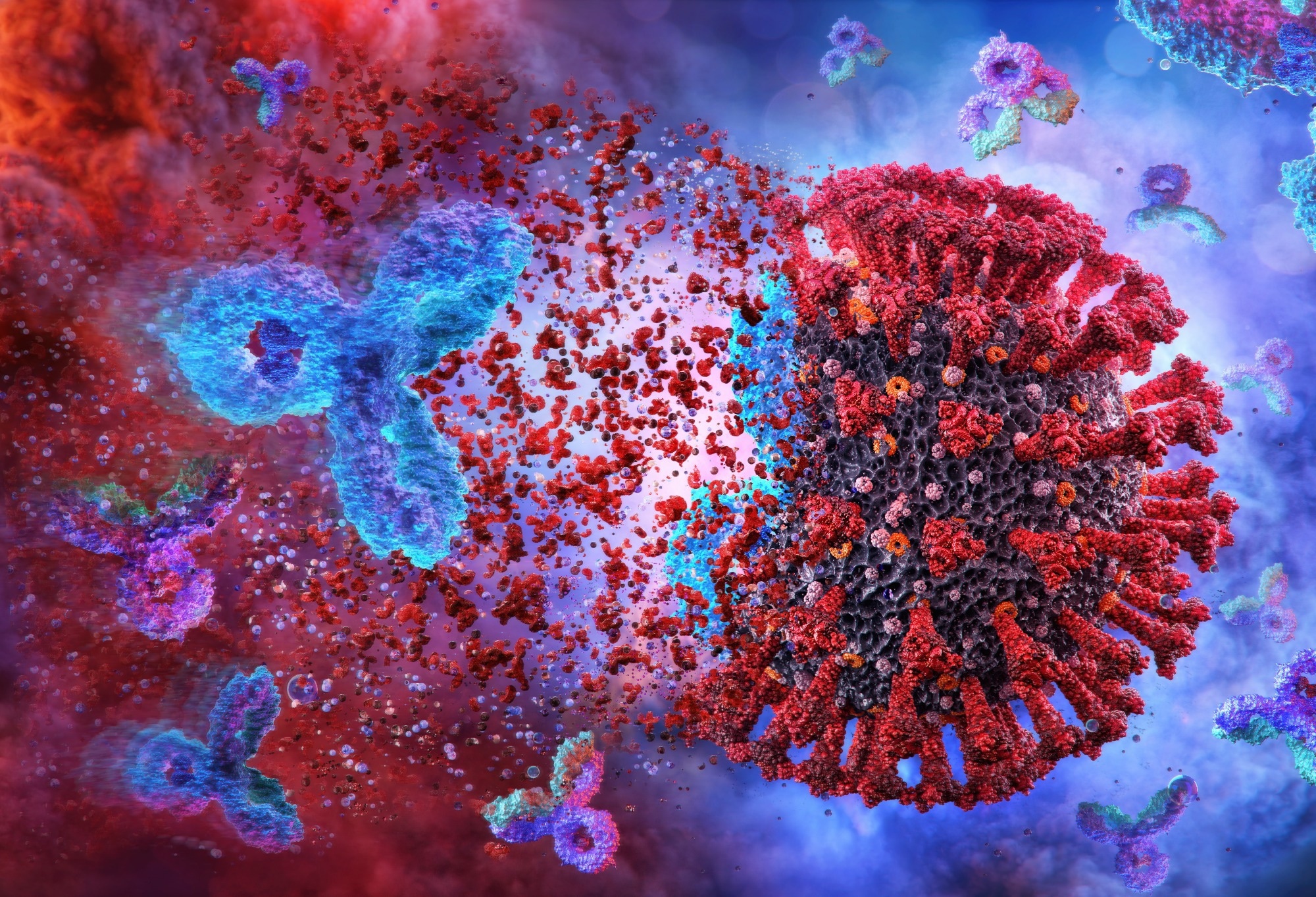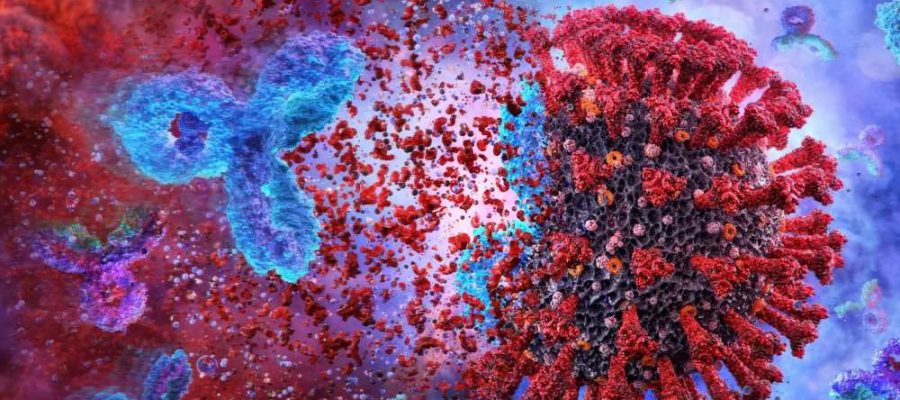In a recent study posted to the bioRxiv* preprint server, researchers assessed the influence of rapid engineering of severe acute respiratory syndrome coronavirus 2 (SARS-CoV-2) therapeutic antibodies to expand the neutralization spectrum.

Background
Antibody therapies serve as the standard of care for immunocompromised individuals prone to adverse coronavirus disease 2019 (COVID-19) infection. However, antibody therapies approved for the COVID-19 treatment have displayed waning efficacy shortly after the emergence of new strains. Given the threat of reinfection, broadly active monoclonal antibodies (MABs) are urgently required for the prevention and/or treatment of high-risk individuals.
Existing methodologies for engineering neutralizing therapeutic mAbs depend on the isolation of antibodies from vaccinated or infected persons or from vaccinated humanized mice. However, this method is not well-suited for quickly evolving targets like SARS-CoV-2, for which the lead discovery phase needs repetition whenever a novel variant emerges.
About the study
In the present study, researchers developed a method that adapts the neutralization breadth of antibodies in real-time as SARS-CoV-2 variants evolve.
Soon after the COVID-19 pandemic began, the team developed a therapeutic candidate mAb using the rabbit discovery approach, which combined rabbit vaccination with Fab-phage display. The team immunized rabbits with the SARS-CoV-2 Wuhan-Hu-1 strain receptor-binding domain (RBD) and selected phage libraries on the Wuhan-Hu-1 spike protein trimer. Using the Fab neutralization assay, an effective clone C-A11 was identified. Then, complementarity-determining regions (CDRs) were grafted on a human framework to generate hN2Y, a humanized clone, which displayed robust neutralization of Wuhan-Hu-1.
The team utilized the stage-enhanced maturation (STEM) platform to increase the neutralization efficacy of hN2Y against newly emerging SARS-CoV-2 variants. This STEM platform sampled the broadest diversity of sequences across all CDRs, such as mutations that operate cooperatively and include developability criteria during selection.
Single CDR mutant hN2Y libraries were generated. These distinct CDR libraries were initially screened on the Wuhan-Hu-1 spike trimer in order to remove non-binders and separate a large number of unique clones. To expand the breadth of neutralization, the library of combined light chains was chosen for the SARS-CoV-2 Beta variant, while the combined heavy chain library was chosen independently for the Alpha, Gamma, Beta, and Epsilon variants.
Neutralization titers associated with either monoclonal antibodies or serum samples were determined using the surrogate virus neutralization test (sVNT), which measured the blockage of recombinant spike trimer against recombinant angiotensin-converting enzyme-2 (ACE-2) protein by enzyme-linked immunosorbent assay (ELISA). In this experiment, the team immobilized the recombinant human Fcγ-tagged ACE2 receptor and pre-incubated the immunoglobulin (Ig)-Gs with the spike trimer prior to adding the blocked wells that were coated with ACE2. Tested IgGs included the original neutralizing rabbit mAb C-A11, LxC1-G10 with mutations in light chain CDRs, the parent humanized clone hN2Y, and 6R8/6R9 clones with alterations in heavy as well as light chain CDRs.
Results
Antibodies eBook

The study findings showed that LxC1-G10, a remarkable candidate from the combined light chain library, demonstrated excellent neutralization of SARS-CoV-2 Omicron BA.1 and BA.2 variants. The library was chosen based on BA.2.75.2, BA.5, XBB, and BQ.1.1 variants, all of which have an F486 mutation, which is suspected to be a key contributor to the loss in activity of LxC1-G10. After eight or nine of panning, a heterogeneous collection of seven very effective, widely neutralizing IgGs (6R8/6R9 clones) was found.
Notably, humanizing the rabbit antibody did not dramatically lower efficacy, as hN2Y maintained comparable neutralizing activity for the Wuhan-Hu-1 strain and Delta variants as C-A11. However, the IgGs displayed remarkably lowered neutralization of the original Omicron BA.1 variant.
LxC1-G10-mediated neutralization of initial Omicron variants was greatly enhanced to low ng/mL half maximal inhibitory concentration (IC50) values with respect to BA.1, BA.2, BA2.3.20, and BA2.75 as well as BN.1. However, the IgGs lost their potency against the BA.2.75.2 variant, which differed significantly from the others because of the F486S and R346T mutations. Furthermore, BQ.1 and BA.5 lacked the R346T mutation but carried the F486V mutation, while LxC1-G10 did not appreciably neutralize these variants. This indicated that the F486 mutation was the most important factor contributing to the loss of activity in LxC1-G10.
The affinity of hN2Y for the Beta variant was slightly lower than that of the original rabbit clone C-A11, whereas the affinity of LxC1-G10 increased to a low pM binding KD. LxC1-G10 displayed a KD affinity of 24 pM for BA.1, which was a five-fold improvement over hN2Y. However, the binding affinity of LxC1-G10 declined by almost 100-fold from 24 pM for BA.1 to 2.1 nM for BQ.1.1. Additionally, seven 6R8/6R9 IgGs had a KD of 7 pM or less for BQ.1.1 and less than 70 pM for XBB.1.5.
Bebtelovimab demonstrated weak binding towards BQ.1.1 but no binding to XBB.1.5. Neither Tixagevimab nor Cilgavimab displayed binding to XBB.1.5 or BQ.1.1 versions. On the other hand, the engineered IgGs exhibited low pM binding KD for the most recent circulating Omicron variants.
Conclusion
The study findings highlighted the validation of the innovative STEM platform. The team could successfully regain potency via engineering against SARS-CoV-2 variants. The researchers believed that the present strategy can be used for the future generation of therapeutic mAbs against SARS-CoV-2 or other viruses, allowing for the rapid development of widely neutralizing therapeutic mAbs.
*Important notice
bioRxiv publishes preliminary scientific reports that are not peer-reviewed and, therefore, should not be regarded as conclusive, guide clinical practice/health-related behavior, or treated as established information.
- Kevin C Entzminger, Jonathan K Fleming, Paul D Entzminger, Lisa Yuko Espinosa, Alex Samadi, Yuko Hiramoto, CJ Okumura, Toshiaki Maruyama. (2023). Rapid engineering of SARS-CoV-2 therapeutic antibodies to increase breadth of neutralization including XBB.1.5 and BQ.1.1. bioRxiv. doi: https://doi.org/10.1101/2023.01.25.525589 https://www.biorxiv.org/content/10.1101/2023.01.25.525589v1
Posted in: Medical Science News | Medical Research News | Disease/Infection News
Tags: ACE2, Angiotensin, Antibodies, Antibody, Assay, binding affinity, Coronavirus, Coronavirus Disease COVID-19, covid-19, Efficacy, ELISA, Enzyme, Immunoglobulin, Mutation, Omicron, Pandemic, Protein, Receptor, Respiratory, SARS, SARS-CoV-2, Severe Acute Respiratory, Severe Acute Respiratory Syndrome, Spike Protein, Syndrome, Virus

Written by
Bhavana Kunkalikar
Bhavana Kunkalikar is a medical writer based in Goa, India. Her academic background is in Pharmaceutical sciences and she holds a Bachelor's degree in Pharmacy. Her educational background allowed her to foster an interest in anatomical and physiological sciences. Her college project work based on ‘The manifestations and causes of sickle cell anemia’ formed the stepping stone to a life-long fascination with human pathophysiology.
Source: Read Full Article
